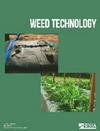2,4- d胆碱对敏感棉结实的影响
IF 1.7
3区 农林科学
Q3 AGRONOMY
引用次数: 0
摘要
随着抗生长素棉花种植面积的增加,麦草畏和2,4- d胆碱在种植前、种植中和种植后的应用数量增加,以帮助控制包括抗草甘膦的苋菜在内的麻烦的阔叶杂草。更多麦草畏和2,4- d胆碱的应用意味着脱靶运动的风险增加。2019-2021年,在德克萨斯理工大学新交易研究农场进行了实地研究,以评估抗麦草畏棉花在四个生育期(初开(FS) + 2周(周)、初开(FB)、FB + 2周和FB + 4周)施用不同剂量2,4- d胆碱时的反应。2,4- d胆碱浓度分别为1060(1倍)、106(1/10倍)、21(1/50倍)、10.6(1/100倍)、2.1(1/500倍)和1.06(1/1000倍),分别施用于Deltapine 1822 XF棉花。与未处理的对照相比,在FS + 2周和FB时,由于2,4- d胆碱含量≥1/100倍,所有年份的产量都出现了损失。在FB + 4周的施用中,只有1倍的2,4- d胆碱用量导致三年内产量下降。在2019年、2020年和2021年的不同时间,2,4- d胆碱的1/10倍和1倍倍率对马克隆值、纤维长度和均匀性产生了负面影响。此外,短纤维含量、羽结和种皮羽结增加,而马克隆、纤维长度和均匀性则受到负面影响。本文章由计算机程序翻译,如有差异,请以英文原文为准。
Effects of 2,4-D choline on fruiting in sensitive cotton
With the increase in hectares planted to auxin-resistant cotton, the number of preplant, at-plant, and post plant applications of dicamba and 2,4-D choline to aid in the control of troublesome broadleaf weeds including glyphosate-resistant Palmer amaranth has increased. More dicamba and 2,4-D choline applications means an increased risk of off-target movement. Field studies were conducted in 2019-2021 at the Texas Tech University New Deal Research Farm to evaluate dicamba-resistant cotton response to various rates of 2,4-D choline when applied at four growth stages [first square (FS) + 2 weeks (wk), first bloom (FB), FB + 2 wk, and FB + 4 wk]. Applications of 2,4-D choline were applied at 1060 (1x), 106 (1/10x), 21 (1/50x), 10.6 (1/100x), 2.1 (1/500x), and 1.06 (1/1000x) g ae ha-1 to Deltapine 1822 XF cotton. Relative to the non-treated control, yield losses were observed in all years at FS + 2 wk and FB from rates of 2,4-D choline ≥ 1/100x. At the FB + 4 wk application, only the 1x rate of 2,4-D choline resulted in a yield reduction in all three years. Micronaire, fiber length, and uniformity were negatively influenced by the 1/10X and 1X rates of 2,4-D choline at various timings in 2019, 2020, and 2021. In addition, short fiber content, neps, and seed coat neps increased where micronaire, fiber length, and uniformity were negatively impacted.
求助全文
通过发布文献求助,成功后即可免费获取论文全文。
去求助
来源期刊

Weed Technology
农林科学-农艺学
CiteScore
2.90
自引率
21.40%
发文量
89
审稿时长
12-24 weeks
期刊介绍:
Weed Technology publishes original research and scholarship in the form of peer-reviewed articles focused on understanding how weeds are managed.
The journal focuses on:
- Applied aspects concerning the management of weeds in agricultural systems
- Herbicides used to manage undesired vegetation, weed biology and control
- Weed/crop management systems
- Reports of new weed problems
-New technologies for weed management and special articles emphasizing technology transfer to improve weed control
-Articles dealing with plant growth regulators and management of undesired plant growth may also be accepted, provided there is clear relevance to weed science technology, e.g., turfgrass or woody plant management along rights-of-way, vegetation management in forest, aquatic, or other non-crop situations.
-Surveys, education, and extension topics related to weeds will also be considered
 求助内容:
求助内容: 应助结果提醒方式:
应助结果提醒方式:


